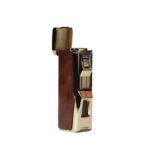Menu
Menu

The process of making cigars is an intricate art form that combines skill, patience, and a deep understanding of tobacco. This blog post will take you on a journey through the fascinating process of how cigars are made, from the cultivation of the tobacco leaves to the final product that is enjoyed by aficionados around the world.
The journey of a cigar begins with the cultivation of tobacco plants. The quality of a cigar largely depends on the quality of the tobacco leaves used, which is further influenced by the climate, soil, and care taken during the growing process. These factors not only apply to the quality, but can also have an affect on the notes and flavors of the final product.
Seed Selection: The process starts with selecting the right seeds. There are various types of tobacco seeds, each resulting in different flavors and characteristics of the final product. The seeds are carefully chosen to ensure the desired qualities in the cigar.
Planting: Tobacco seeds are initially sown in seedbeds and covered with a thin layer of soil. The seedlings are nurtured until they are strong enough to be transplanted to the fields. This phase requires attentive and thorough care to protect the young plants from pests and diseases. These can completely ruin the tobacco, which is costly considering how long the process of making a cigar is.
Growing and Harvesting: Tobacco plants take several months to mature. During this time, they require constant attention, including watering, weeding, and protection from pests. Once the tobacco plants reach the desired size, the leaves are harvested.
After the tobacco leaves are harvested, they undergo curing and fermentation processes to develop their flavor profile and other qualities.
Curing: The curing process involves drying the tobacco leaves to remove moisture. There are several methods of curing, including air curing, fire curing, flue curing, and sun curing. Each of these methods deliver different characteristics to the tobacco and affects the sugar content and nicotine content of the leaves.
Fermentation: Once the leaves are cured, they undergo fermentation to further develop their flavor profile The leaves are stacked in piles or “pilones” and allowed to ferment naturally. Just like fine wine, once it starts fermenting, all of the more prominent flavors and notes are developed. This process usually takes several months and requires frequent monitoring to make sure the humidity levels and temperature are where they need to be.
After fermentation, the tobacco leaves are sorted and aged to refine their flavor and quality. This is where some of the more subtle notes and undertones come out.
Sorting: The leaves are sorted based on their size, texture, color, and quality. This step is crucial as it determines which leaves will be used for the different parts of the cigar: the filler, binder, and wrapper.
Aging: The sorted leaves are then aged to allow their flavors to mature and mellow. This aging process can take several months to several years. During this time, the leaves are stored in controlled environments, either bales or barrels, to maintain their quality. Where they are stored will have an impact on how the final product will smell and taste. Similar to how bourbon can heavily vary in flavor and smoothness based on the types of barrels they’re aged in.
Rolling cigars is a highly skilled craft that requires years of practice to master. It involves several steps, each contributing to the cigar’s final quality and appearance.
Selecting the Filler: The filler is the inner part of the cigar and consists of a blend of different tobacco leaves. The choice of leaves and their proportions determine the cigar’s flavor and strength. The filler leaves are bunched together in a specific way to ensure an even burn.
Choosing the Binder: The binder is a leaf that holds the filler together. It must be strong enough to keep the filler in place but also contribute to the cigar’s overall flavor. The binder leaf is wrapped around the filler to form the “bunch.”
Applying the Wrapper: The wrapper is the outermost leaf and is considered the most important part of the cigar in terms of appearance and flavor. It must be smooth, elastic, and free of blemishes. The wrapper is carefully rolled around the bunch, and the end of the cigar is sealed with a small piece of tobacco.
Selecting the right accessories is almost as important as selecting the right cigars. When you invest in quality cigars, it’s crucial to not overlook the importance of good accessories. Humidors are essential for keeping your goods secure and fresh. Quality cutters ensure a clean cut so you don’t unravel the tobacco. And a reliable cigar lighter will give you peace of mind, knowing that it won’t go out on you.



